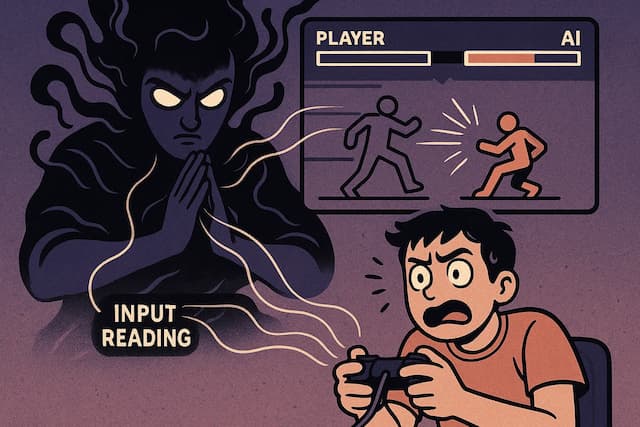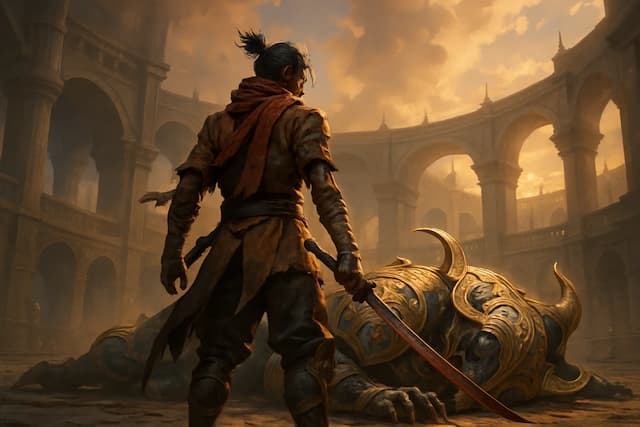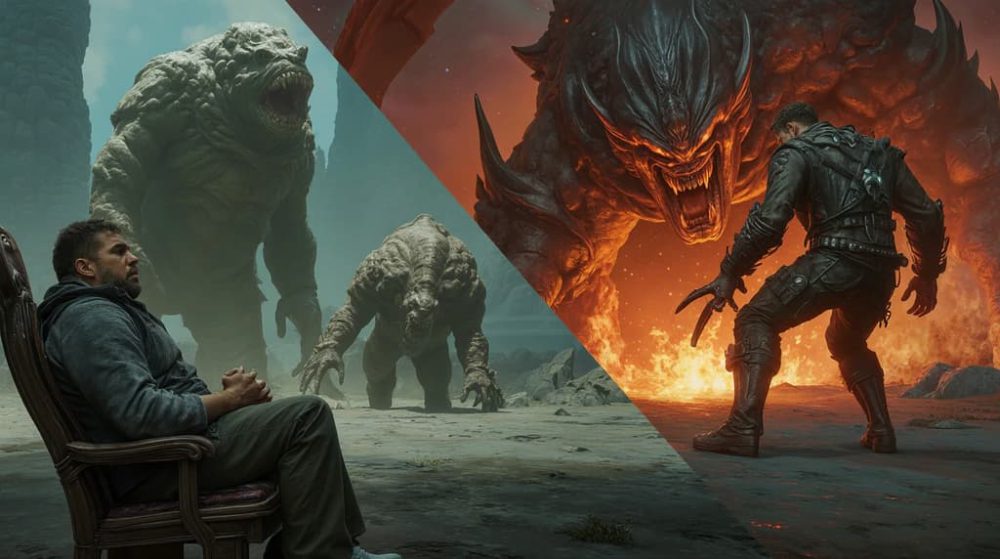We’ve all been there. You’re facing a boss a towering behemoth of a creature and you’ve mastered its attack patterns. You can dodge, parry, and counter every move it makes. You are, for all intents and purposes, playing perfectly. Yet, the fight drags on for twenty excruciating minutes, not because it’s mechanically complex, but because the boss has a health bar the size of a small planet. Your victory, when it finally comes, doesn’t feel earned; it feels like you just finished a tedious chore. This, right here, is the rotten core of fake difficulty in games.
True difficulty is a masterful dance of skill, strategy, and perseverance. It respects the player’s intelligence and rewards mastery. Artificial difficulty, on the other hand, is a cheap trick. It’s a design crutch that punishes players instead of challenging them, creating frustration that sours otherwise excellent games. Understanding the difference is crucial for players who want to find truly rewarding experiences. In a community that values authentic gaming experiences like the one at Dafy Gaming Hub, recognizing these design flaws helps us champion better games. This article will break down the common tactics of fake difficulty, explore why developers resort to them, and celebrate the games that get true, satisfying challenge right.
What Is Fake Difficulty? A Test of Patience, Not Skill
At its core, fake difficulty in games is the practice of making a game harder without making it more strategically or mechanically complex. It doesn’t ask the player to improve their skills, learn new patterns, or think more creatively. Instead, it creates obstacles through tedious, unfair, or frustrating mechanics that often feel like the game is cheating. It’s the illusion of a challenge, designed to waste your time rather than test your abilities.
A genuine challenge respects the player. It operates on a consistent set of rules, provides clear feedback, and presents obstacles that can be overcome with practice and understanding. Unfair game design, however, breaks this unspoken contract. It relies on arbitrary rules and mechanics that feel random and unearned.
Let’s compare the two directly:
|
Genuine Difficulty ✅ |
Fake Difficulty ❌ |
|
Demands mastery of core mechanics. |
Demands repetitive, tedious actions. |
|
Enemies have complex, learnable patterns. |
Enemies have massively inflated health and damage. |
|
Rules are consistent for both player and AI. |
AI has unfair advantages (e.g., input reading). |
|
Failure teaches the player a valuable lesson. |
Failure forces players to replay long, boring sections. |
|
Rewards skill, strategy, and critical thinking. |
Rewards grinding and time investment over skill. |
Think of a boss in Sekiro: Shadows Die Twice. The challenge comes from learning precise timing for deflections and identifying openings. Your success is a direct result of your own improvement. Now, contrast that with a generic RPG enemy whose only threatening quality is its astronomical HP pool. The first is a test of skill; the second is a test of your patience. Spotting these issues before you invest hours into a game is vital, which is why proper game reviews that analyze game mechanics are so important for helping players differentiate a true challenge from a frustrating waste of time.
Common Tactics of Fake Difficulty
Developers have a whole bag of tricks for creating artificial difficulty. While some of these elements can be used effectively in moderation, they become cheap game mechanics when they are the primary source of a game’s challenge.

- Inflated Health and Damage (The “Damage Sponge”)
This is the most common and laziest form of fake difficulty. Instead of designing an enemy with interesting mechanics, developers simply crank its health and damage numbers to absurd levels. The fight doesn’t become more strategic; it just becomes longer and more punishing. You’re not learning anything new by hitting the same weak spot for fifteen minutes straight. It turns combat into a war of attrition, disrespecting the player’s time and skill. - Unavoidable One-Shot Kills
A well-telegraphed, highly damaging attack is a fair mechanic. It teaches the player to recognize a threat and react accordingly. An unavoidable, off-screen sniper shot or an enemy that kills you before its animation even registers is not. These one-shot kills don’t test your reaction time; they test your memory through trial and error. It’s an unfair game design that creates “gotcha!” moments instead of opportunities for skillful play. - Aggressive Resource Starvation
Some games build their entire identity around resource management, like Resident Evil or Darkest Dungeon, and that’s fantastic. It becomes a cheap game mechanic when the game severely limits resources like ammo, healing items, or save points without a strategic purpose. When your only path forward is to grind for hours to farm healing potions or backtrack through an entire level because of a poorly placed save point, the challenge is no longer about smart decision-making; it’s about enduring tedium. - Unfair AI Advantages and Input Reading
This is when the game truly cheats. “Input reading” occurs when an AI opponent reacts to your controller inputs the instant you make them, often before your character’s animation even begins. Did you press the button for a heavy attack? The AI immediately performs the perfect counter. It feels less like you’re fighting a sophisticated opponent and more like you’re battling a psychic entity that has access to your thoughts, a classic example of artificial difficulty. - Arbitrary and Punishing Time Limits
Time limits can create a thrilling sense of urgency when used correctly. When used poorly, they force players to rush recklessly, ignoring strategy in favor of blind panic. A mission that fails instantly because you spent two seconds too long in a firefight doesn’t feel tense; it feels cheap and restrictive.
Why Do Developers Use These Tactics?
If these mechanics are so widely disliked, why do they keep appearing in games? The reasons are often tied to the pressures and realities of game development.
First, using fake difficulty is an easy way to pad a game’s length. In an industry where players sometimes equate a game’s value with its total playtime, turning a 20-hour adventure into a 40-hour one by simply doubling enemy health is a tempting shortcut. It’s a way to justify a premium price tag without investing in more content.
Second, these tactics can mask shallow content or underdeveloped AI. If you don’t have the time or budget to program a complex and intelligent enemy AI, you can make it seem formidable by having it hit like a truck. A damage sponge boss requires far less development resources than a multi-phase encounter with unique, scripted behaviors. Budget and time constraints often force developers to cut corners, and nuanced difficulty balancing is one of the first things to go.
Finally, there can be a fundamental misunderstanding of what makes “hard” games appealing. The success of titles like Dark Souls led some to believe that players just want to be punished. They mistake the rewarding, skill-based challenge of those games for pure, unrelenting punishment, leading them to implement unfair game design in a misguided attempt to capture that same “hardcore” audience.
The Psychology of Player Frustration: Good vs. Bad Pain
Not all frustration is created equal. In gaming, there is “good frustration” and “bad frustration,” and fake difficulty is the fast track to the latter.
“Good frustration” is the feeling of failing but knowing why you failed. It’s the driving force behind the “one more try” phenomenon. When you’re defeated by a fair boss, your reaction is, “Okay, I see. I dodged too early. I need to wait for that tell.” This kind of frustration is motivating because it provides a clear path to improvement. It engages you, respects your agency, and makes eventual victory feel incredibly rewarding.
“Bad frustration,” born from unfair game design, does the opposite. It makes the player feel powerless. The reaction isn’t, “I can do better,” but rather, “This is total nonsense.” When you’re killed by a random, unavoidable attack or fail a mission due to a punishingly spaced checkpoint, you don’t feel motivated to improve. You feel like the game is wasting your time. This type of frustration breaks immersion, erodes trust, and is a leading cause of why players abandon games. A quick look at any gaming forum will show you countless threads of players dropping a game not because it was too hard, but because it felt unfair.
The Games That Get It Right

Thankfully, many developers understand the difference and have created masterpieces of game design that offer a firm but fair challenge. These games prove that difficulty can be a tool for engagement, not a barrier to it.
- Hades
Supergiant’s rogue-lite masterpiece is a masterclass in adjustable difficulty. The “Heat” system allows players to selectively add modifiers that make the game harder in specific, understandable ways. You can make enemies faster, give them new abilities, or limit your own healing. This empowers players to fine-tune the challenge to their exact skill level, and every layer of difficulty adds a new strategic element to consider, not just bigger health bars. - Sekiro: Shadows Die Twice
FromSoftware is known for its challenging games, but Sekiro is perhaps their purest expression of fair, skill-based combat. The entire game is built around the posture and deflection system. There is no way to grind for higher stats to overpower a boss. You must learn the core mechanic. Every enemy, from the lowliest soldier to the final boss, operates on these same rules. The game is brutally demanding, but it never cheats. Victory feels earned because it is a direct reflection of your own mastery. - Celeste
This precision platformer is notoriously difficult, but it’s also one of the most encouraging and accessible games ever made. Its “Assist Mode” allows players to tweak the mechanicslike game speed, stamina, or even invincibilitywithout judgment. The developers understood that a player’s journey is their own. It allows everyone to experience the game’s incredible story and design, proving that a high level of challenge and broad accessibility can, and should, coexist. Community reception to design choices like these is almost universally positive.
Conclusion: A Call for Better Challenges
Fake difficulty in games is more than just a minor annoyance; it’s a design philosophy that fundamentally disrespects the player. It trades rewarding, skill-based challenges for tedious, time-wasting obstacles. It pads game length, masks shallow mechanics, and creates a sense of profound, unfulfilling frustration. While legitimate challenges push us to improve and reward us with a powerful sense of accomplishment, artificial difficulty just leaves us feeling cheated.
As players, the best thing we can do is learn to recognize these cheap game mechanics and celebrate the games that get it right. By supporting developers who invest the time and effort into creating deep, fair, and engaging challenges, we can help steer the industry toward a future where difficulty is once again synonymous with skillful design, not just bigger numbers. To make informed choices, lean on community resources and detailed game reviews that dig deeper than surface-level impressions. Your time is valuable don’t let a game waste it with a challenge that isn’t worthy of your skill.
